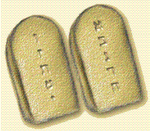.
.

The season of Lent, beginning with Ash Wednesday, is devoted to an intensive study of the Passion of Christ, this feature becoming unusually pronounced in Holy Week, with the culmination in the great happening of Good Friday, in the death and burial of Christ. The length today of the Lenten season is for forty days. While such a period is indicated as early as the third century, Apostolic Tradition, its length is indefinite prior to Nicaea. Thereafter it is spoken of as the fast of forty days and spans a period of six weeks with prior to Easter (as in Rome and fourth-century Alexandria) or prior to Holy Week (as in Syria, Constantinople, and eventually all the Eastern churches). In the early church the Lenten season was a time for the catechumens to make preparations for baptism, but by the end of the fourth century in the West it was also a period for the ritual of humiliation of the penitent. This led to the Christian liturgical traditions that observe the Lenten fast experience as a time of "dying to self," so as to participate fully in the renewal of life in the celebration of Christ's resurrection. The custom of fasting during Lent started at a very early date, but the length of the fast varied, eight days being customary at first, but the time was extended to forty days, after the analogy of the period included in the Lord's temptation, Matt. 4:2. Gregory II, is said to have fixed the Wednesday now known as Ash Wednesday (from the custom of daubing the foreheads of the worshipers on that day with the ashes of last year's palms, in token of mourning) as the first day of Lent in order to secure uniformity of observance throughout the Church. The season of preparation for Easter closed with the Great or Black Week, also known as the Holy Week.
.
.
.

The season of Lent, beginning with Ash Wednesday, is devoted to an intensive study of the Passion of Christ, this feature becoming unusually pronounced in Holy Week, with the culmination in the great happening of Good Friday, in the death and burial of Christ. The length today of the Lenten season is for forty days. While such a period is indicated as early as the third century, Apostolic Tradition, its length is indefinite prior to Nicaea. Thereafter it is spoken of as the fast of forty days and spans a period of six weeks with prior to Easter (as in Rome and fourth-century Alexandria) or prior to Holy Week (as in Syria, Constantinople, and eventually all the Eastern churches). In the early church the Lenten season was a time for the catechumens to make preparations for baptism, but by the end of the fourth century in the West it was also a period for the ritual of humiliation of the penitent. This led to the Christian liturgical traditions that observe the Lenten fast experience as a time of "dying to self," so as to participate fully in the renewal of life in the celebration of Christ's resurrection. The custom of fasting during Lent started at a very early date, but the length of the fast varied, eight days being customary at first, but the time was extended to forty days, after the analogy of the period included in the Lord's temptation, Matt. 4:2. Gregory II, is said to have fixed the Wednesday now known as Ash Wednesday (from the custom of daubing the foreheads of the worshipers on that day with the ashes of last year's palms, in token of mourning) as the first day of Lent in order to secure uniformity of observance throughout the Church. The season of preparation for Easter closed with the Great or Black Week, also known as the Holy Week.
.
The Thursday of Holy Week commemorated the institution of the Holy Supper. Since the Gospel of the day was John 13:1-15 , the day was also known as the Day of Foot Washing. Its present English name of Maundy Thursday is derived either from the words of the Gospel lesson: "Mandatum novum do vobis," or from the custom of carrying gifts to the poor in maund(y) baskets on that day.
.
Good Friday, almost from the first, was the Day of the Cross, a day of deepest mourning, with a compete fast till 3 or 6 o'clock in the afternoon. In some churches no form of service was prescribed for Good Friday, the faithful merely came together for silent prayer.
.
.
Lenten Wreath
.
.
The Lenten Wreath, made of rose vines and thistle, represents the "Crown of Thrones' placed upon our Lord's head by Pontius Pilate when he mockingly proclaimed Him to be "The King of the Jews". There are six white candles--one lit consecutively each of the six weeks in Lent--and one black candle that is lit on Good Friday, and three nails depicting the nails used to place Christ upon the cross.
..
.
.
Lenten Tree Cross
.The large Tree Cross , in the front of the church, is made from the trunk of a Christmas Tree that was used here at Historic Trinity during the Christmas Season. This worship aid helps to demonstrate us that Jesus Christ the Son of God who's birth we celebrate at Christmas, came into the world and took on the form of the Son of Man, that He might lay down His life upon the Cross as the Lamb of God in payment for the sins of all persons. Mary His Mother, and John the Disciple, are represented by the two figures who are standing before the cross.
.
.
.
.
.
Historic Trinity Lutheran Church1345 Gratiot Avenue Detroit, Michigan 48207








